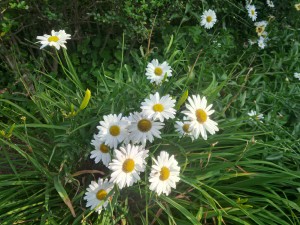My great-Aunt Adeline, known as “Queenie” to the family, was a small woman who carried a big broom. She swept the front sidewalk every morning, even if there was not a single ant, grass blade or maple samara to be seen. When she and my grandmother “turned out the corners” of the house for seasonal cleaning, even the dust motes were afraid.
I think of this when I contemplate the summer clean-up chores in my garden. I wish I could resurrect Aunt Queenie to help get the project under control.
People generally undertake garden clean-up in spring and fall, but I find that summer has its own brand of untidiness. In hot weather, the plants need us, their handlers, enablers and occasional tormenters, even more than in more temperate seasons. That is why summer clean-up a necessity.
My plant holding area is a big mess. In spring I buy most of my new plants, because waiting until early summer means that the selection is limited, even if the bargains are plentiful. The problems start when I can’t plant all of my purchases right after I buy them. They end up in into the holding area—or more properly, “areas”, since I have one on my driveway and one on the back porch. The holding area is convenient, but it should not continue to harbor spring-purchased plants in mid-summer. My first and most urgent task is to liberate those languishing specimens from their nursery/starter pots and either get them in the ground or into larger pots positioned in locations that might become permanent homes. Nursery pots do not give plants much room to stretch their roots, and leaving plants in them for too long is a good way to put those plants on the path to terminal decline.
The Shasta daisies have fled the scene, after producing a bumper crop of flowers this year. The daisies are swiftly being overtaken by the rambunctious asters and before the Shastas are completely engulfed, they should be thinned. I am lucky that they have fairly shallow-roots, so getting them out is easy. It also allows the roses, swamped for weeks by the daisy tidal wave, to breathe and flower once more.
It is axiomatic in gardening that dense planting crowds out weeds. That rule, while inspiring, does not always hold true. As I thin out the daisies, I invariably find weeds lurking among them. The most vigorous is stiltgrass, sometimes known as Mary’s weed and dubbed Microstegium vimineum by plant taxonomists. It is not a familiar, old-timey weed, like crabgrass or dandelion, but a relative newcomer to my area. It arrived in the 1980’s, like shoulder pads, parachute pants and the Sony Walkman. Unlike them, it has multiplied exponentially ever since. Featuring long, slender stems and elongated, almost grassy leaves, stiltgrass loves the edges of beds—where you can usually spot it—but does not eschew the middle of densely planted areas, where it is harder to see. It is also very easy to pull up, so a good summer clean-up on my property always includes an attempt at stiltgrass eradication
With those holding area plants looming large in my mind, I have to decide which plants I should clean out all together. At some point in time, I bought a small tansy plant for its ferny foliage and yellow, button-like flowers. Now I have an enormous amount of tansy that is taking up space that would be better used for holding area plants that I have stronger feelings for. There is nothing really wrong with tansy, a traditional aromatic strewing herb and dye plant. It is simply invasive and standing between me and a more inspiring garden. I might save a small clump and grow it in a pot, but even that is only a slim possibility.
A well-mulched garden is a neater and less weedy expanse, so part of my clean-up is a put-down–of the bags of shredded cedar mulch currently stacked at the rear of my driveway. Lugging the bags is occasionally painful, but the satisfaction I get from a fragrant, well-ordered bed is ample compensation.
And when I finish all of the above, I still have to trim back the spent lily foliage, not to mention eradicting the wasps’ nest in my upper back garden so I can finish removing the scraggly miniature box shrub next to it. I hate to evict any living creature, but the painful wasp stings that I have gotten while working on the box plants have convinced me that it is time. With the wasps and the box gone, I can finish work on the lavender hedge that I started planting weeks ago.
If all goes according to plan, the lavender plants will be the last specimens to leave my holding area. Then I will be able to rest easy—at least until the stiltgrass makes a dramatic return.
